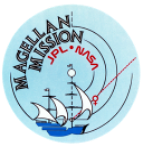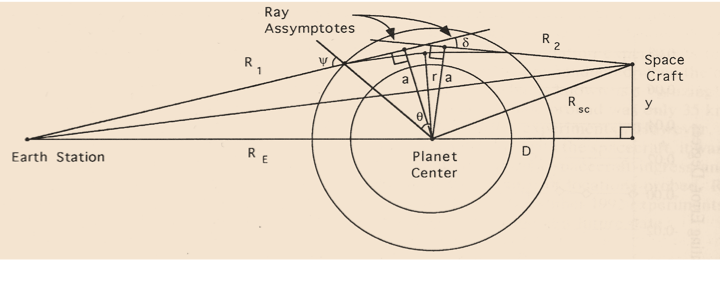
Introduction
The Magellan Radio Science investigations utilized instrumentation with elements on the spacecraft and at the DSN. The spacecraft radio system was constructed around a redundant pair of NASA Standard Transponders (NSTs) that received and transmitted at both S-band (2.3 GHz, 13 cm wavelength) and X-band (8.4 GHz, 3.6 cm wavelength) frequencies. The exact transmitted frequency was controlled by the signal received from a ground station or by an on-board oscillator.
While the system was primarily designed for radar studies of the Venus surface, the high effective isotropic radiated power (EIRP) from the Magellan spacecraft made it an ideal transmitter for use in radio occultation measurements of the refractivity and absorptivity of the Venus atmosphere. Experiments, utilizing transmissions at 2.3 GHz and 8.4 GHz (13 cm and 3.6 cm, respectively), were carried out during spacecraft ingress. Because the stability of the spacecraft transmitter is critical for accurately determining the Doppler shift and amplitude attenuation created as the ray penetrates the atmosphere, the spacecraft transmitter was locked to a 2.1 GHz uplink from a 70-meter DSN station that also received the signals.
To deal with the high directivity of the spacecraft antenna, and the significant ray bending in the deep Venus atmosphere, a spacecraft-tracking maneuver was designed to keep the spacecraft antenna pointed in the direction of the refracted ray path back to Earth. This yielded 3.6 cm refractivity and absorptivity profiles down to the 35 km altitude and 13 cm profiles down to the altitude of critical refraction (approximately 33 km). The statistical uncertainties in the derived profiles are significantly lower than those previously obtained, resulting in extremely accurate profiles of temperature, pressure, density and H2SO4 (g) abundance including orbit-to-orbit variations.
References
Steffes, P.G., J.M. Jenkins, et al., Radio Occultation Studies of the Venus Atmosphere with the Magellan Spacecraft: 1. Experimental Description and Performance,Icarus, 110, 71-78, 1994."
Jenkins, J.M., P.G. Steffes, et al., Radio occultation studies of the Venus atmosphere with the Magellan spacecraft: 2. Results from the October 1991 experiments, Icarus, 110, pp. 79-94, 1994.
Accessing the Raw Data
MGN-V-RSS-1-ROCC-V2.0 is a data set containing The Magellan (MGN) Radio Occultation (ROCC) Raw Data Archive (RDA) and is a time-ordered collection of raw and partially processed data from radio occultation experiments conducted using the Magellan spacecraft while it orbited Venus. The spacecraft radio system was used as the signal source. The spacecraft high-gain antenna (HGA) beamed those signals through the atmosphere of Venus toward Earth, where they were received at stations of the NASA Deep Space Network (DSN). See dataset.cat. The data are located in the following volumes.
mg_2201
mg_2202
mg_2203
mg_2204
mg_2205
mg_2206
mg_2207
mg_2208
mg_2209
mg_2210
mg_2211
mg_2212
mg_2213
mg_2214
Accessing the Derived Data
Two data sets are available that were derived from from dual-frequency ingress radio occultation experiments using the Magellan orbiter on three consecutive orbits (#3212 - #3214) on October 5 and 6, 1991.
RTPD - The MGN-V-RSS-5-OCC-PROF-RTPD-V1.0 data set includes vertical profiles of refractivity, temperature, pressure and density in the neutral Venus atmosphere. (see rtpd under catalog and data)
ABS - The MGN-V-RSS-5-OCC-PROF-ABS-H2SO4-V1.0 data set includes vertical profiles of 13-cm and 3.6-cm absorptivity and abundance of sulfuric acid vapor (H2SO4). (see abs under catalog and data)
ABS - The MGN-V-RSS-5-OCC-PROF-ABS-H2SO4-V1.0 data set includes vertical profiles of 13-cm and 3.6-cm absorptivity and abundance of sulfuric acid vapor (H2SO4). (see abs under catalog and data)
 PDS: The Planetary Atmospheres Node
PDS: The Planetary Atmospheres Node


